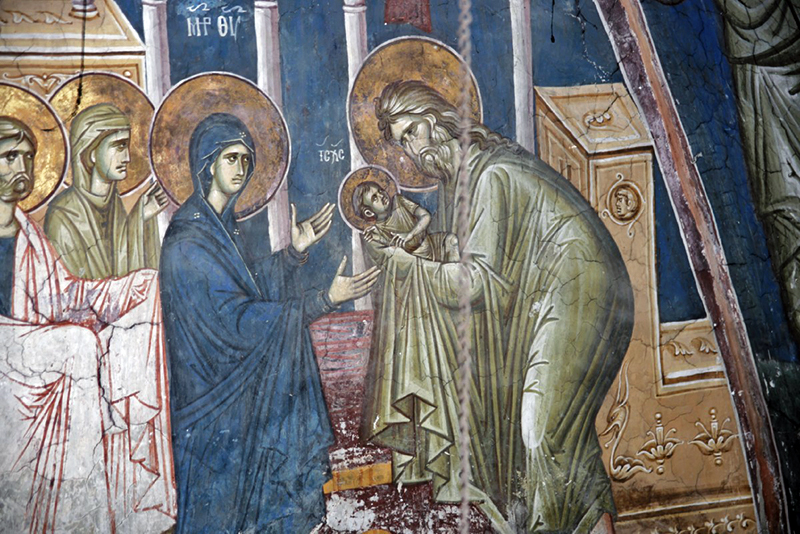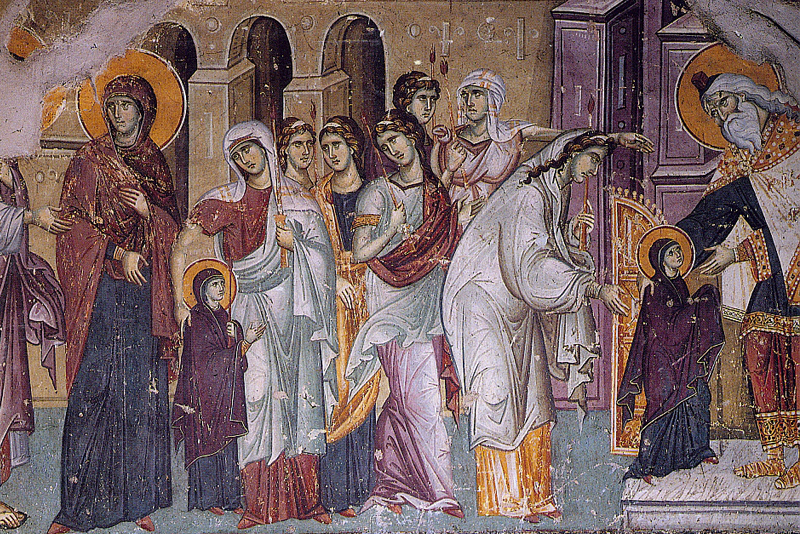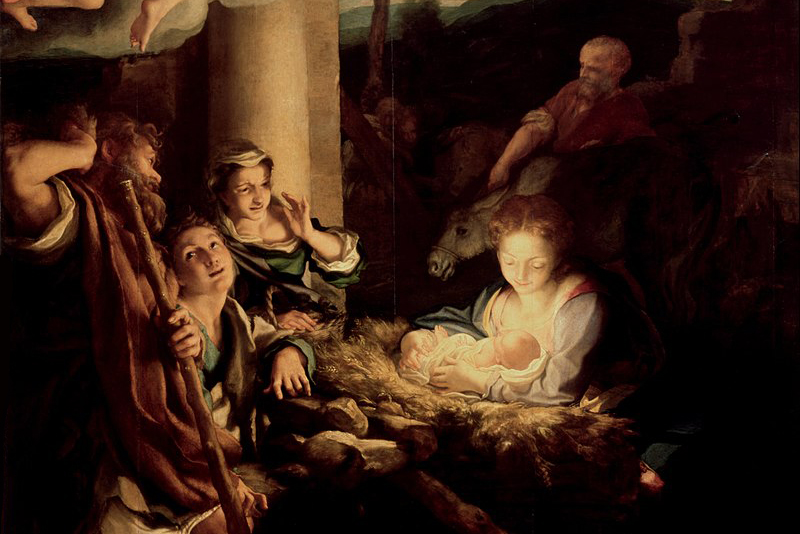
Today’s feast has many meanings, many aspects, and even many names. It is sometimes called the Meeting of the Lord, sometimes the Purification of the Virgin, sometimes the Presentation of Christ in the Temple, and finally, especially in the West, it is known as Candlemas – the Feast of the Light that shown upon St. Symeon and which we remember by blessing candles on this day. This multiplicity of names and meanings is an indication that today’s feast is situated at a crossroads: between the Law and the Prophets, between the infancy and the adulthood of Christ, between the Old and the New Covenant. Today, for the first time in history, God Himself enters bodily into the Temple which was made for Him, carried in the arms of Her who is Herself the true Holy of Holies, the Tabernacle more spacious than the heavens. He enters not in a cloud of glory, but in humble poverty, in meekness fulfilling the Law which He Himself gave. And She enters to be purified, She who alone is spotless and undefiled. Here the Righteous Symeon prophecies over Him who is the fulfillment of all the Prophets.
It is no accident that the Holy Church has ordained that this feast be celebrated very near to the beginning of Great Lent, because this feast is also the first feast of the Resurrection. In this feast we are given a foretaste of the Lord’s Pascha, seeing for the very first time death, no longer as an enemy to be feared, but rather as a doorway which opens unto the salvation of God, which was “prepared before the face of all people.” In this feast, the death of St. Symeon the God-Receiver has begun to be touched by the life of Christ. He lived on this earth for 360 years, preserved by the grace of God in order to behold the coming of the Anointed One; and though he yet descended into Sheol, the hymns of the Holy Church tell us that he preceded St. John the Forerunner in preaching the coming of eternal life to the souls imprisoned there.
This feast is also one that is especially monastic in its character. It is a Feast of the Lord, the one Whose life and words all monastics strive to imitate so far as is possible. It is a Feast of the Mother of God, the Heavenly Mother and Protector of all monks and nuns. And it is a feast of the holy Elder Symeon and the Prophetess Anna, two saints who lived a life dedicated to prayer and fasting, abiding in the Temple while awaiting the coming of their Lord. But above all, for monastics this feast is the feast of the remembrance of death.
The remembrance of death, though it may seem dour, morbid and joyless to those who love only the fleeting pleasures of this dying life, is today shown to be the only source of true joy, life, and happiness. The life of St. Symeon reveals with remarkable clarity and power the truth that is so cleverly hidden from those who try to hide and cover over by every possible means the looming reality of death. Such unfortunate ones imagine that long life is the highest possible good. Our world today is absolutely obsessed with this delusion, very often seeking to prolong life at any cost, employing various grotesque and humiliating medical techniques to add even a few days or weeks to a person’s life, days and weeks which are usually filled only with suffering and pain, numbed into oblivion by powerful narcotics.
St. Symeon lived on this earth for 360 years. By the reasoning of our contemporaries, such a lifespan is to be greatly envied. Yet what must it have actually been like for him? One by one, to see his family, his friends and his relatives grow old and die? To see his nation enslaved, his people humiliated; to see the slow decay of all those places which he had known and loved as a young boy? To endure while his body grew ever more weak and feeble with each passing year? Truly, this vain and corruptible world holds no lasting happiness or pleasure. Man was indeed made for eternal life, but clearly he was not made for eternal life in this world.
Yet to recognize the vanity of this world and its pleasures is not enough. This knowledge is shared by the Hindus and Buddhists, even by our modern existentialists and nihilists. St. Symeon’s remembrance of and desire for death went far beyond the desire of Eastern mysticism and modern philosophy to escape into oblivion, into a nothingness beyond the reach of the suffering of life. Far from it. The essence of St. Symeon’s remembrance of death was nothing other than an eager and joyful anticipation of the apocalypse, that is to say the unveiling of Christ in His gladsome and glorious light.
For St. Symeon, for monastics, and for every Christian, the miracle of Christ’s Incarnation, Passion and Resurrection lies precisely in that Christ filled all things, even and especially death, with Himself. In the words of the Psalmist: “If I go up into heaven, Thou art there: if I descend into Hades, Thou art present there, if I take up my wings toward the dawn and make mine abode in the uttermost parts of the sea, even there shall Thy hand guide me and Thy right hand shall hold me.” The prophecy that St. Symeon should not taste death until he had seen the Lord’s Christ was in fact a double prophecy. It was a prophecy also for the life of every Christian and for every human being: to taste death and to behold Christ are now one and the same.
But though this prophecy caused St. Symeon to depart this life in peace and gladsome joy, this was so only because he had lived all his life in the remembrance of this prophecy, and had shaped his entire life around it. He had died already to everything transient, to everything sinful, and it was this that allowed his death to become an entrance into life. As it is written above the gates of one holy monastery: “If you die before you die, when you die, you shall not die.”
For although to taste death and to behold Christ have now become one, this truth is joyful only to those who love Christ; it is exceedingly bitter to those who do not. Resurrection will come at the last day to all men, but the Scriptures warn that only for some will it be a resurrection unto life while for others, a resurrection unto damnation. And so we see once more why the Holy Church has placed this feast near to the beginning of the Great Fast. It is a feast of joy, life, light and resurrection… but it is a feast that can only be entered into through the gates of suffering, repentance, bright sorrow, and ultimately, death.
We all have a choice before us: will we willingly accept suffering and death for the sake of the love of God, and behold these very things being transformed into the source of our joy and eternal life and blessedness? Or will we run and hide from suffering and death, only to find at the end of all things that we cannot run and hide any longer, and that having refused to meet Christ in them, we are left with suffering and death only, stripped of Christ and of all meaning forever? To suffer and to die are inevitable. Our only choice is for whom we will suffer, and to what we will die. Through the prayers of the Holy Righteous Symeon the God-Receiver and the Holy Prophetess Anna, through the intercessions of the Holy Theotokos and Ever-Virgin Mary, and through the grace and mercy of the only Lover of Mankind, may we enlightened by the Gladsome Light of this holy feast-day, so that we may make our choice wisely. Amen.
Source: https://blogs.ancientfaith.com/rememberingsion/2018/02/14/gates-death-sermon-meeting-lord/




